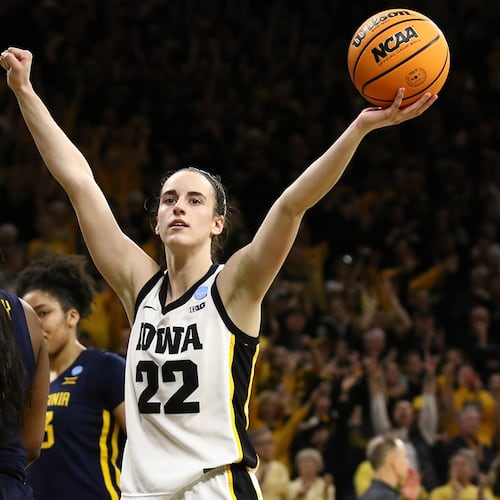Every year, someone broaches the subject of playoff expansion. Here’s who we’d have gotten had the 2020 edition grown to eight teams: Georgia, which lost to 4-8 South Carolina and to No. 1 LSU by 27 points; Oregon, which lost to three-loss Auburn and five-loss Arizona State; Baylor, which lost twice to Oklahoma, and Wisconsin, which lost to 6-6 Illinois and twice to Ohio State by an aggregate 44 points.
Do you believe any of those four could have won a quarterfinal? Maybe Georgia as No. 5 Oklahoma against No. 4 Oklahoma, but that’s it. Such a victory would have again matched the Bulldogs against LSU, which would have been another no-chancer. Six years into the College Football Playoff, I still believe four is plenty. This year, four was too many.
This Oklahoma was the worst of the four OU teams that have made the College Football Playoff. It might have been — with the possible exceptions of Michigan State in 2015 and Notre Dame last year — the weakest playoff team. Only three teams mattered this season. Two will play for the title here tonight. The third was Ohio State, which on another night would have beaten Clemson in the Glendale semifinal. Thing is, Clemson is unbelievably tough to beat.
Here we move to our next point: The CFP was instituted to give more teams — two more, to be precise — a shot. I’d argue that the playoff has, in the main, been good for the sport. It hasn’t, however, been quite as good as a lot of people, this one included, expected.
The first CFP final paired Ohio State and Oregon. Those weren’t Cinderellas — Ohio State had graced three BCS finals; Oregon had made one — and they snapped, if only for a year, the run of consecutive SEC appearances title-game appearances at eight. Five years later, we look again.
Neither the Big Ten nor the Pac-12 has qualified for a final since. No Big 12 team has won a semifinal. No Big 12 team other than Oklahoma has made the field. Over six installments, the CFP's 24 berths have been filled by 11 teams. Clemson, Alabama, Oklahoma and Ohio State have filled 17 of the 24. Your past five finals:
January 2016: Alabama/SEC vs. Clemson/ACC.
January 2017: Clemson/ACC vs. Alabama/SEC.
January 2018: Alabama/SEC vs. Georgia/SEC.
January 2019: Clemson/ACC vs. Alabama/SEC.
January 2020: LSU/SEC vs. Clemson/ACC.
Four different teams from two conferences. Four different teams from the Deep South. We concede the SEC now includes outposts in Missouri and Texas, while the ACC has stretched to Pennsylvania, New York and Massachusetts, but still: Is anyone in Boston geeked for this final because B.C. shares the Atlantic Division with Clemson?
TV-wise, the highest-rated CFP final was the first. Ohio State-Oregon drew a rating of 18.6, per Sports Media Watch. No other final has come close. Alabama-Clemson I drew a 15.0, Alabama-Clemson II a 14.2, Alabama-Clemson III a 13.8. Alabama-Georgia, featuring teams from the same conference, is actually the second-highest final at 15.6.
The highest-rated semifinals were also the first semifinals — Ohio State-Alabama and Oregon-Florida State from January 2015. And: This year’s LSU-Oklahoma semifinal, which saw LSU score 49 points in the first half, was the third-lowest CFP game ever.
I remember being in the airport in Dallas after the Ohio State-Oregon final and talking with some ESPN folks. They were giddy about the semifinal ratings, and they were hoping the title game would have done even better. Those numbers arrived while ESPNers were in flight. More giddiness ensued.
I can’t imagine anything involving the CFP since has made the Worldwide Leader dance with glee. The playoff is a great property to have; no one disputes that. Its weekly ranking reveals have become must-see TV. The tournament has stirred conversation about college football in a newer and broader-based way. (“Who’s In?”) But has the CFP, six years into its existence, become all we thought it might be? Not yet.
Much of it has to do with geography. The phone lines on New York’s WFAN aren’t shorting out over Dabo vs. Coach O, or even Burrow vs. Lawrence. The regional aspect of college football that limited the appeal of the BCS — the SEC won its title seven years running; a team from Alabama played for the BCS championship every year from January 2010 through January 2014 — remains in place.
That’s not the CFP’s fault, and it’s not ESPN’s. SEC teams and Clemson, which could be mistaken for an SEC team, have come to rule the sport. Above the interstate heading into downtown here is an SEC billboard: “Welcome to the home of More.”
I say again: On paper, this final is the best the CFP has produced. I do, however, wonder how it’ll play in Poughkeepsie and Peoria. I also wonder if going 15 days between semis and final will have killed any buzz emanating from Joe Burrow’s seven touchdown passes in a half and the pulsating Clemson-Ohio State finish.
Since the semifinals were staged on Dec. 28, the NFL has had time to play its final regular-season games, a four-game Wild Card Round and a four-game Divisional Round. By the morning of Jan. 13, 2020, the hottest Southern football team wasn’t LSU or Clemson — it was the Tennessee Titans.
I live in Atlanta, where an ACC team is based and where the SEC stages its championship game. I have no problem watching LSU and Clemson fight it out for the title. (When last they met, it was in the Chick-fil-A Peach Bowl on New Year’s Eve 2012; I covered that one, too.)
That said: For the sake of the CFP and college football writ large, it wouldn’t hurt if next year’s final matched Ohio State against somebody not from the SEC/ACC. The Ohio State part could happen. The non-SEC/ACC part? Probably not. When it comes to this sport, the South remains the home of More.
About the Author
The Latest
Featured



